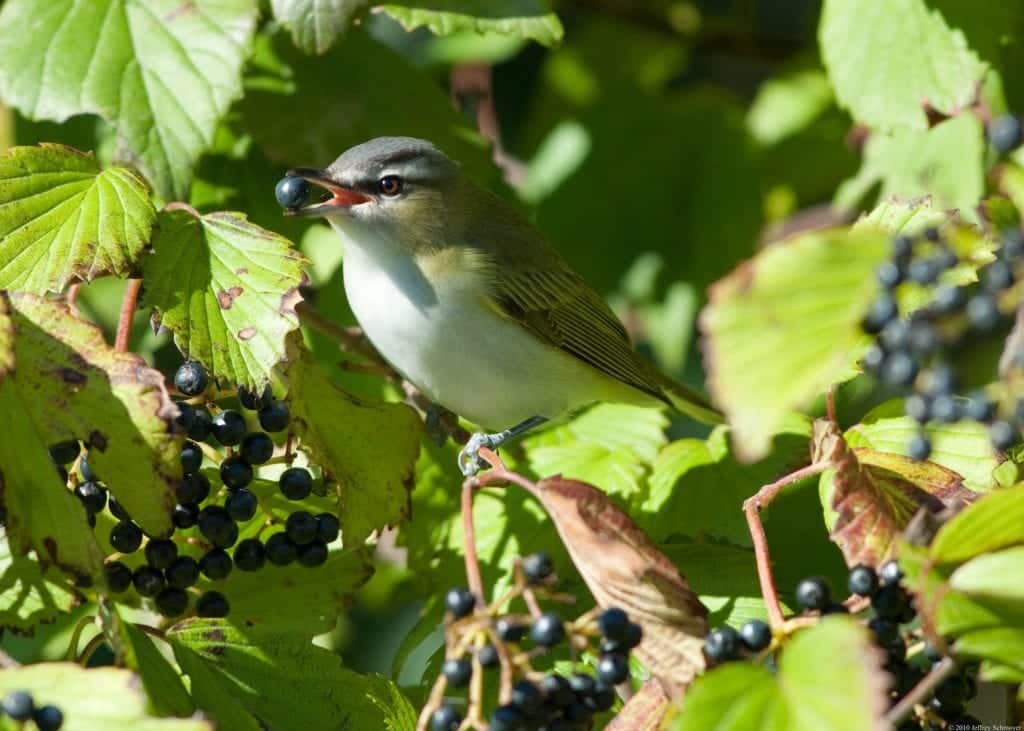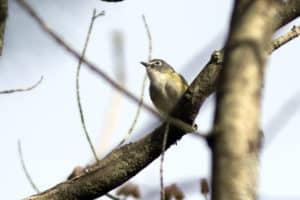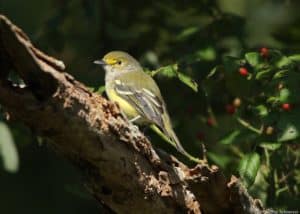
It’s not always easy to identify Maine’s most beloved birds. Maine Audubon biologists and naturalists commonly field identification questions along the lines of “is it this, or is it that?” Many species look similar from a distance, but there are some great telltale signs, both visual markers and behaviors, that can help identify species. This is an occasional series to try to help you know what you are looking at!
Vireos are small songbirds that can be difficult to see and even more difficult to identify. They have distinctive thick, blunt-tipped bills that are hooked at the end and they frequent dense foliage, often in the forest canopy, foraging for insects and fruit. They are more often heard than seen, with distinctive songs of simple phrases, whistled repeatedly. Superficially similar to warblers at a distance, vireos tend to sit still for longer periods of time, and generally have thicker necks and bills than warblers. There are several different ways to differentiate the common vireos of Maine.
Geography and Habitat
The most common vireo in eastern North America is the Red-eyed Vireo (V. olivaceus), pictured above. They nest all over Maine in any deciduous or mixed woods, and are one of the most commonly heard birds during summer. Blue-headed Vireos (V. solitarius) are the second-most common of our vireos and also nest all over Maine, with higher concentrations farther north, usually in mixed deciduous forests. Warbling Vireos (V. gilvus) are third-most common, nest mostly in southern Maine in deciduous forests near freshwater, and are seldom encountered away from water. Philadelphia Vireos (V. philadelphicus) nest only in western and northern Maine in deciduous forests, usually birch and poplar, and elsewhere are seen only during migration, mostly in the fall.
Yellow-throated Vireos (V. flavifrons) nest only in southern Maine, usually in large areas of deciduous forest, and are the least commonly-seen vireo that nests here. The most common vagrant species, the White-eyed Vireo (V. griseus), is most frequently seen near the coast, and is generally seen in shrubbier foliage than most other vireos.
Timing

Blue-headed Vireos are the first vireo species to arrive in Maine during the third week in April, and peak by the second week of May. Warbling Vireos are next, beginning in the first week of May, and peaking by the middle of the month. From that point through the summer, Red-eyed Vireos are the most common by far, followed by Blue-headed and Warbling Vireos. In the fall, Philadelphia and Warbling Vireos peak in the second and third weeks of September, and are all but gone by the beginning of October. Red-eyed Vireos start to move through in the second half of September, and are mostly gone by the third week of October, with Blue-headed Vireos becoming the more commonly-seen species from October through the end of migration. Some Yellow-throated Vireos nest in southern Maine, but are not commonly encountered. The other rarer vireos, mainly White-eyed Vireos, are usually encountered during migration.
Song
Most vireos have similar-sounding songs with repeating whistled phrases, and learning their songs is often the best way to locate and identify vireos in dense foliage. Red-eyed Vireos have the most well-known song of clear, whistled phrases like “here I am, where are you, way up here, in the tree”, averaging about one phrase every two seconds. Most other vireos sing slower versions of this same template. Blue-headed Vireos sing slightly more slurred and slow, averaging one phrase every two and a half seconds, like “see you, so long, cheerio”. Philadelphia Vireos sing at a similar rate, but more high-pitched phrases that are very close to the Red-eyed Vireos’ song. Yellow-throated Vireos sing the slowest of all, one phrase every three seconds, with slurred phrases like “three eight, three-o.”

Warbling Vireos sound completely different from most of our other vireos: its phrases are rapidly warbled together, somewhat like a finch. White-eyed Vireos sing a similarly-structured song, but the phrases are slower and sharper, and often contain mimics of other species’ call notes (frequently including Gray Catbird “meows”).
Visually
If you are lucky enough to see a vireo, there are a few tricks to distinguish them visually. They can be broken up into two distinct groups based on plumages: those with plain wings and those with wingbars. Red-eyed, Warbling, and Philadelphia Vireos all have plain wings. Red-eyed Vireos’ wings and back are olive-green (as their scientific name suggests), their belly is bright white, and they have dark eyelines with reddish eyes. They have the longest bill of any of our vireos, and generally are the largest vireo encountered in Maine. Warbling Vireos are the drabbest of all our vireos, pale gray overall with a white belly, dark eye, and smaller bill than Red-eyed Vireos. Philadelphia Vireos are in-between Red-eyed and Warbling Vireos: they are gray above and white below, with a pale yellow throat, dark gray eyeline, and dark eyes. They tend to be similar in size and shape to Warbling Vireos.
Blue-headed, Yellow-throated, and White-eyed Vireos all have wingbars, in addition to spectacle-like eyerings. All three are a bit stockier in shape, with more distinctive plumages than the plain-winged vireos.
